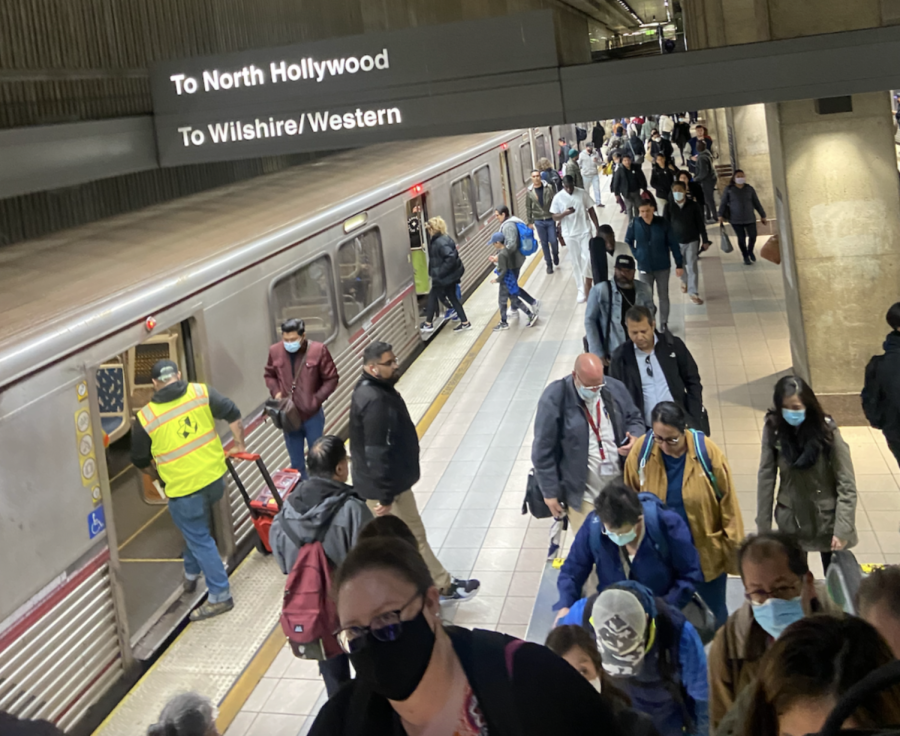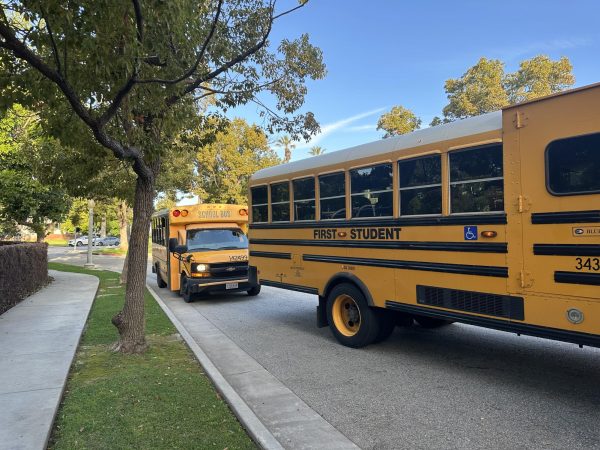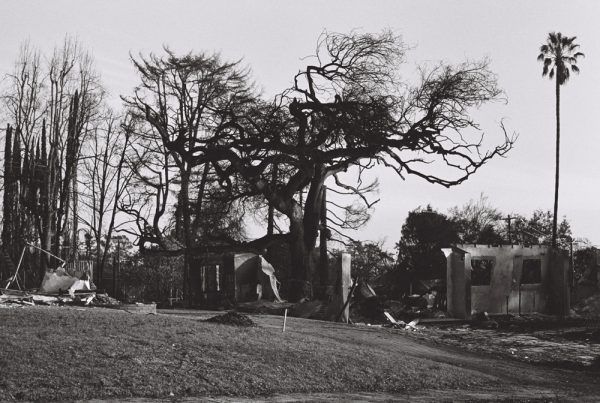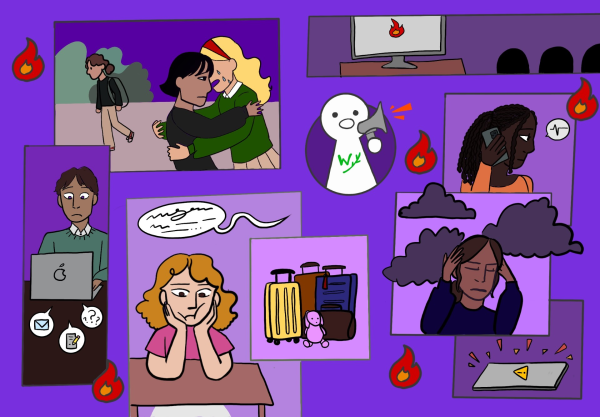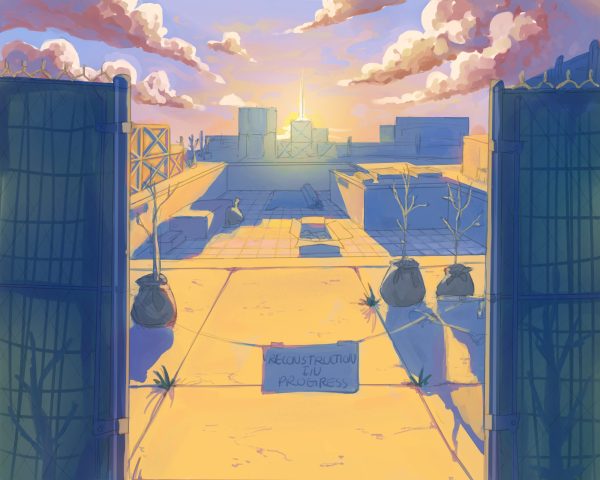Who Needs Cars When You Have the Metro? The Appeal of L.A. Public Transits Outweighs the Cons for Local Riders
Commuters getting on and off the North Hollywood metro at Union Station.
When I first hopped on the Metro, I had no idea about the world that I was missing out on. Originally, I sat behind my two friends on the Metro Gold Line trying my best not to stare at the sleeping person wearing a sweatshirt and a beanie across from me and holding a long wooden stick. Another woman carrying a bag of books and a red and purple satchel rushed through the closing Metro doors, targeted her eyes on me, and immediately sat next to me. During the ride, I never spoke to the woman. Instead, I stared out the window taking in the countless different neighborhoods filled with yellow and orange apartments with spray paint messages on the side, tall gray buildings that have fire escapes that go on forever, and even a garden filled with little orange flowers.
Normally, I would never choose to use the Metro. I have heard of harassment, crimes, and other unsavory encounters from Metro riders. But my experience indicated nothing of the kind. The most harrowing part was figuring out my transfer, but even that was mitigated by a kind gentleman who pointed me in the right direction. I can see why so many people use public transportation on a daily basis.
Los Angeles isn’t exactly known for its public transit system. Compared to other cities, commuters are more likely to brave Los Angeles’ sprawling freeway and notorious traffic. But those who can and do use public transit regularly cite many benefits: it’s affordable, fast, and eco-friendly.
At Westridge, many members of the community choose to use public transportation to travel to school for countless reasons. Jennifer Cutler, Upper School history teacher, has used the Metro for the majority of her life because she’s always lived in cities and used public transportation. “As soon as I found out that Pasadena had a train line, and I lived close enough to a train line, it was sort of like a no-brainer…Public transportation is so much easier,” she said.
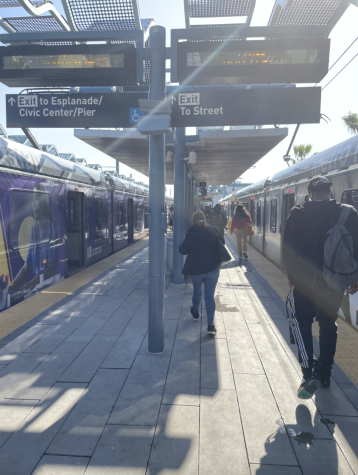
Upper School teachers Ryan Skophammer and Autumn Rogers both feel very passionate about the Metro because it has made their lives easier and they can travel much more quickly without needing their cars.
“I’ve been taking transit since my first day here. Two years of a long commute made me hate driving, and I wanted to do something [different],” said Dr. Skophammer.
“A big upside [of using public transit] is that I save a lot of money. Getting rid of a car and not having to pay for maintenance, and gas, and parking, and insurance and all of that stuff—it saves a lot of money. Not having to worry about parking is great, too,” said Rogers.
Teachers aren’t the only ones using public transit. Westridge students also use public transportation to travel around the city with friends and even family.
Olivia C. ’25 said, “I take the Metro pretty frequently. Like this Friday, I was going to Old Town, and there was nobody home to drive me. So I just took the bus to Old Town, and it was fine.”
Students who don’t drive or have cars find public transportation to be a great alternative that offers an interesting experience. Dahlia V. ’24 likes the Metro because of the scenery it offers. “Unlike using the freeway, the Metro takes you around Los Angeles with views that are made for people to look out of.”
Although the Metro is a great experience because it allows for two hours of riding for only $1.75 and even has great views, compared to other cities with public transit, Los Angeles faces unique challenges that have made expanding public transit difficult. Given the city’s widespread, horizontal, and in some places rather hilly topography, Los Angeles is challenged when it comes to the development of new infrastructure.
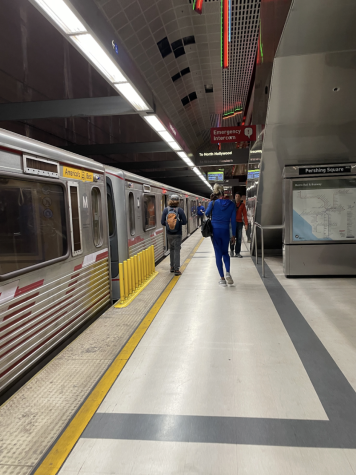
There are a number of newly-proposed transport infrastructure projects popping up across the city. Initiatives like Metro’s Sepulveda Transit Corridor Project aim to install subway and light rail connections between the San Fernando Valley and West Los Angeles, ideally encouraging the use of public transit and cutting carbon emissions from auto traffic.
But the environmental and logistical review processes are so extensive that the project, if approved, wouldn’t be implemented until the mid-2030s. Because of all these reasons, expansion of Los Angeles’ public transit system is losing traction.
One of the upsides to using public transit is the reliability. However, one morning, Rogers learned that her usual KoreaTown Metro station was closed due to flooding, making her unable to get to work.
Along with the infrastructure, recent concerns about safety have caused some commuters to avoid public transportation altogether. The LA Metro reported a drop in ridership by 17 percent since the start of the COVID-19 pandemic. Those riders who continue to use the Metro often encounter individuals actively using drugs or passed out from substance abuse.
In an article titled “Riding public transit in Los Angeles can be scary. Here are some things I’ve seen” from the Los Angeles Times, the author witnessed many instances of people, himself included, being assaulted, both verbally and physically.
According to another article from the Los Angeles Times, drug-use, robbery, and assault on the LA Metro are 24 percent more frequent than in 2022—a pattern Rogers has noticed firsthand.
“Especially as of the last year or so, there are a lot of problems with drug use with erratic behavior. I haven’t really seen any violence, but I have kind of been lucky in that regard. It is fairly often that people are smoking things that are not cigarettes on the train. And it’s not great,” she said.
Rogers uses the Metro to get to school every day and recognizes its many financial and logistical positives, but she also sees a downside. “Los Angeles has ended up shunting [sic] a lot of our problems with homelessness into the transit system. And Metro is not equipped to operate as a homeless shelter or as a social services provider,” Rogers said.
For students, especially, safety is a big concern when deciding how to commute.
“I don’t really feel comfortable using the Metro, and I don’t think my parents would be comfortable with me using the Metro either. There are a lot of dangerous people that use the Metro that would make me feel unsafe,” said Isla R. ’25
Similarly, Alana L. ’25 said, “I wouldn’t feel comfortable taking the Metro alone. Maybe if I were with friends, I would use the Metro but definitely not alone.”
Students like Isla and Alana aren’t personally familiar with the Metro system, but for those who know their way around the Metro, they are more likely to take advantage of public transportation.
Holly N. ’25 also uses the Metro, but she understands the concerns of those who don’t. “I think there is definitely a stigma around riding public transportation. I know my mom isn’t fully comfortable with letting me [use public transit] yet. Especially if I’m alone, she would not let me do it alone. But I think being with friends makes it a little easier for parents to let their kids [use public transit].”
Over the past year, despite the numerous problems that have steered passengers away from using public transit, die-hard users remain.
For many users, public transit isn’t just one option. It’s their only option for transportation. While the Metro needs many improvements, the city is working to solve these problems by obtaining grants and laws according to an article by the LA Times.
Olivia C. ’25 has used the Metro for many years and said she will continue to use it undeterred. “I feel especially comfortable with [the Metro] because I’ve ridden public transportation my entire life. Like since I was in preschool, I used to ride the bus through Highland Park to get to places.”
For Further Reading:
Bloomberg: The Global Mass Transit Revolution
The LA Times: L.A. Metro has problems besides crime and ridership: It’s in the design
TRANSIT MEANS BUSINESS: Transit has a net economic benefit
KCATA: Environmental Benefits of Public Transit
LA Magazine: L.A. Metro Crime Statistics Are An Absolute Horror Show

Lilah is a senior and a fourth year Spyglass staff writer. You can find her watching movies with her friends, shopping at thrift stores, and searching...

Ilena is passionate about stories— especially histories— good snacks, and bad puns. She has been on Spyglass for a very long time. Ilena is a senior.

















![Dr. Zanita Kelly, Director of Lower and Middle School, pictured above, and the rest of Westridge Administration were instrumental to providing Westridge faculty and staff the support they needed after the Eaton fire. "[Teachers] are part of the community," said Dr. Kelly. "Just like our families and students."](https://westridgespyglass.org/wp-content/uploads/2025/03/dr.-kellyyy-1-e1748143600809.png)












































